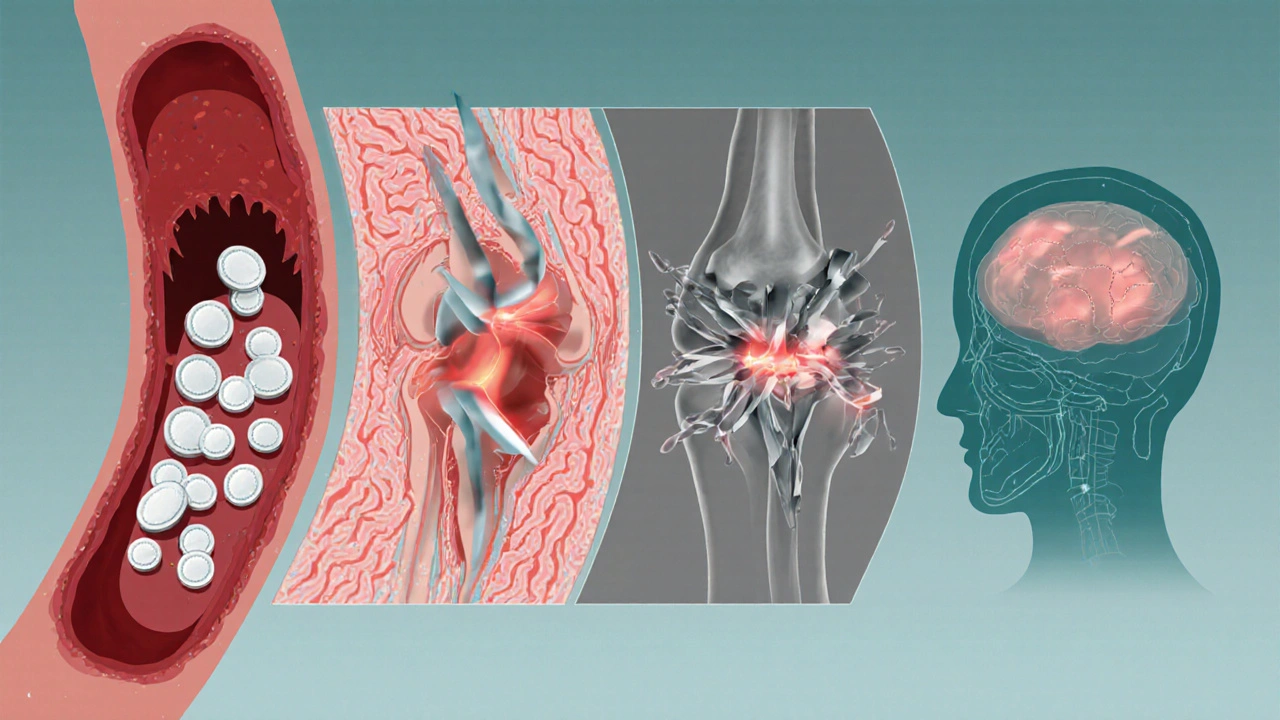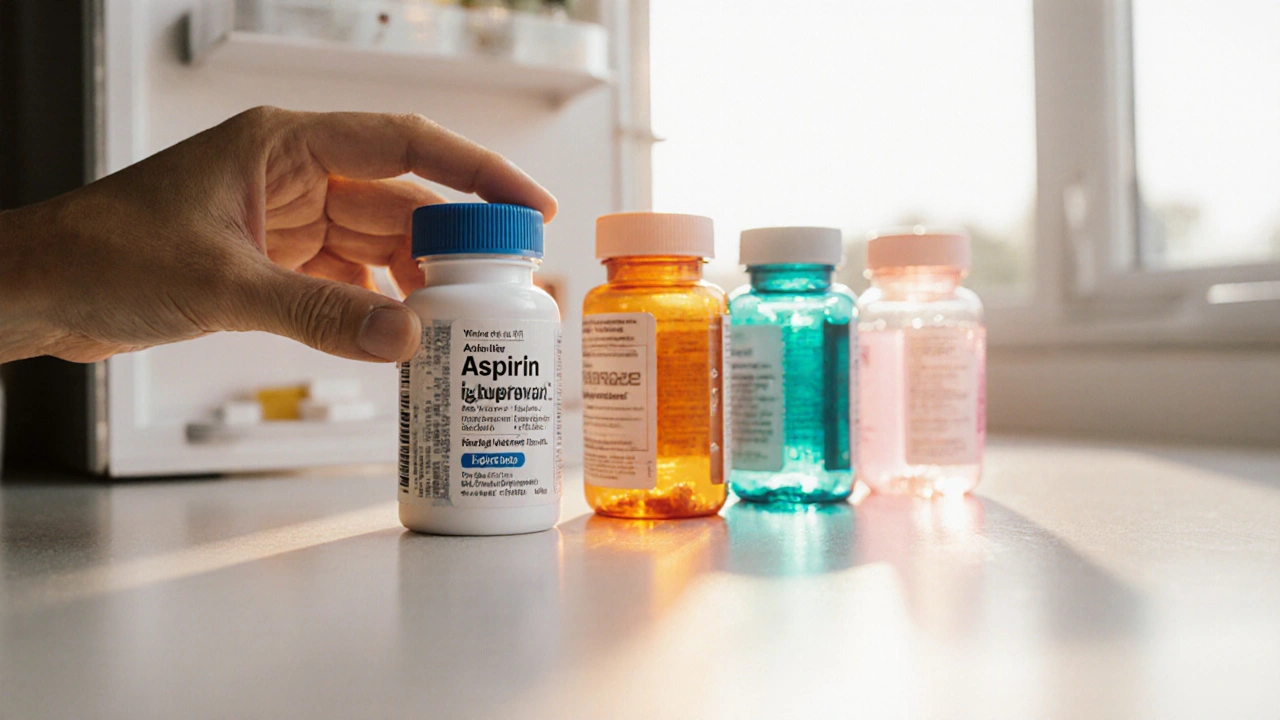Pain Relief Comparison Tool
Best for: Heart protection, mild pain, fever
Key Benefit: Antiplatelet effect reduces clot risk
Risk: Bleeding, stomach irritation
Best for: Inflammation, acute pain
Key Benefit: Strong anti-inflammatory
Risk: Stomach irritation, kidney impact
Best for: Long-lasting relief
Key Benefit: Longer dosing interval
Risk: Similar to ibuprofen
Best for: Fever, mild pain
Key Benefit: Safe for stomach, no inflammation
Risk: Liver toxicity with overdose
Quick Takeaways
- Aspirin is unique among OTC pain relievers for its proven heart‑protective effects.
- Ibuprofen and naproxen are stronger anti‑inflammatories but carry higher gastrointestinal risk.
- Acetaminophen eases fever and mild pain without anti‑inflammatory action, making it safer for the stomach.
- Choosing the right drug depends on the condition you’re treating, your age, and any existing health issues.
- Always check for drug interactions and follow dosing guidelines to limit bleeding risk.
What Is Aspirin?
When people talk about pain relief, Aspirin (acetylsalicylic acid) is a classic non‑steroidal anti‑inflammatory drug (NSAID) that works by inhibiting cyclooxygenase enzymes. First synthesized in 1897, it quickly became the go‑to drug for headaches, fever, and even heart attacks. The key selling point? At low doses, aspirin irreversibly blocks platelet aggregation, lowering the risk of clot‑related events such as heart attacks and strokes.
Here's how Aspirin compares to its peers.
Common Over‑The‑Counter Alternatives
Most shoppers also see these names on the pharmacy shelf:
- Ibuprofen (Advil, Motrin) - a short‑acting NSAID that targets inflammation more aggressively.
- Naproxen (Aleve) - another NSAID, but with a longer half‑life, meaning you dose less often.
- Acetaminophen (Tylenol) - technically not an NSAID; it relieves pain and fever without tackling inflammation.
All three are available OTC in most countries, but each belongs to a slightly different pharmacological family.
How These Drugs Work: The Science in Plain English
At the core of aspirin, ibuprofen and naproxen is the inhibition of cyclooxygenase (often abbreviated as COX) enzymes. COX‑1 helps protect the stomach lining and supports platelet function, while COX‑2 drives inflammation and pain. Aspirin blocks COX‑1 irreversibly, which is why it reduces clotting. Ibuprofen and naproxen are reversible blockers, targeting both COX‑1 and COX‑2, giving them stronger anti‑inflammatory power but also higher stomach‑irritation potential.
Acetaminophen, by contrast, works primarily in the brain’s pain pathways and does not noticeably affect COX enzymes in peripheral tissues. That’s why it doesn’t reduce swelling or protect the heart.

Side‑Effect Landscape
Because they share a COX target, the NSAIDs share common risks:
- Gastrointestinal irritation, ulceration, or bleeding - more pronounced with ibuprofen and naproxen.
- Kidney function impact, especially with high doses or chronic use.
- Potential to raise blood pressure.
Acetaminophen’s main safety concern is liver toxicity. Doses above 3-4g per day can overwhelm the liver, particularly in people who consume alcohol regularly.
Specific to aspirin is the bleeding risk that becomes significant when combined with anticoagulants or in patients with clotting disorders.
Comparison Table: Aspirin vs. Ibuprofen vs. Naproxen vs. Acetaminophen
| Attribute | Aspirin | Ibuprofen | Naproxen | Acetaminophen |
|---|---|---|---|---|
| Typical OTC dose | 81mg (low‑dose) - 325mg (pain) | 200mg every 4‑6h | 220mg every 8‑12h | 500mg every 4‑6h |
| Primary action | Antiplatelet + mild anti‑inflammatory | Strong anti‑inflammatory | Strong anti‑inflammatory, long‑acting | Pain & fever relief only |
| Cardiovascular benefit | Reduces heart attack & stroke risk (low dose) | None proven; may increase risk at high dose | None proven; similar concerns as ibuprofen | No benefit |
| Gastro‑intestinal risk | Moderate - higher with regular doses | High - ulceration common | High - similar to ibuprofen | Low |
| Liver toxicity | Low | Low | Low | High if >3g/day |
| Typical uses | Heart‑attack prevention, mild pain, fever | Back pain, menstrual cramps, arthritis | Arthritis, musculoskeletal pain | Fever, headache, mild to moderate pain |
Choosing the Right Option for Your Situation
Think of drug selection as matching a tool to a job. Below are common scenarios and the best fit.
- Primary prevention of heart attack or stroke - Low‑dose aspirin (81mg daily) remains the only OTC option with proven benefit. Check with a doctor if you have a history of ulcers or are on blood thinners.
- Acute inflammatory pain (e.g., sprained ankle) - Ibuprofen or naproxen will give stronger and faster relief. Naproxen’s longer dosing interval suits people who forget to take meds frequently.
- Fever in children - Acetaminophen is the go‑to because aspirin is linked to Reye’s syndrome, a rare but serious condition in kids.
- Chronic osteoarthritis - A low‑dose naproxen regimen (if stomach protected) often works better than aspirin, but a gastro‑protective agent (like a proton‑pump inhibitor) may be needed.
- Patients with kidney disease - All NSAIDs (including aspirin) can worsen kidney function. Acetaminophen, when kept within safe limits, is generally safer.
Always weigh the benefit against the cardiovascular disease risk and the potential for bleeding risk. For example, an older adult on warfarin should avoid regular‑dose aspirin unless a cardiologist specifically recommends it.
Safety Tips, Interactions, and Common Pitfalls
Even OTC meds can cause trouble if you ignore a few simple rules.
- Read the label for maximum daily dose - never exceed 4g of acetaminophen or 4g of aspirin in 24hours.
- Take NSAIDs with food or a full glass of water to protect the stomach lining.
- Check for hidden aspirin in combination products (e.g., “exfoliant” skin creams may contain aspirin).
- Ask your pharmacist about interactions with blood thinners (warfarin, DOACs), antihypertensives, or SSRIs - the combo can amplify bleeding.
- If you have asthma, note that aspirin and other NSAIDs can trigger bronchospasm in a subset of patients (known as aspirin‑exacerbated respiratory disease).
When in doubt, a quick chat with your GP or pharmacist can prevent a nasty surprise.
Frequently Asked Questions
Can I take aspirin and ibuprofen together?
Usually it’s not recommended because ibuprofen can block the antiplatelet effect of aspirin. If your doctor tells you to take both, keep a 30‑minute gap between doses and follow the prescribed schedule.
Is low‑dose aspirin safe for people over 70?
Age alone isn’t a deal‑breaker, but older adults have higher bleeding risk. A doctor will weigh heart‑attack prevention benefits against stomach and brain bleed hazards before recommending it.
Why is aspirin not recommended for children with fever?
Aspirin has been linked to Reye’s syndrome, a rare but often fatal brain‑liver disorder that affects kids recovering from viral illnesses. Acetaminophen or ibuprofen are safer alternatives.
Which OTC pain reliever works best for menstrual cramps?
Ibuprofen (200‑400mg every 6hours) is often preferred because it reduces prostaglandin production, the main cause of cramp pain. Naproxen works too but needs fewer doses.
Can I use acetaminophen if I have liver disease?
You need to be very careful. Even standard doses can stress a compromised liver. Always discuss dosing with your physician; often a reduced dose or an alternative is advised.


